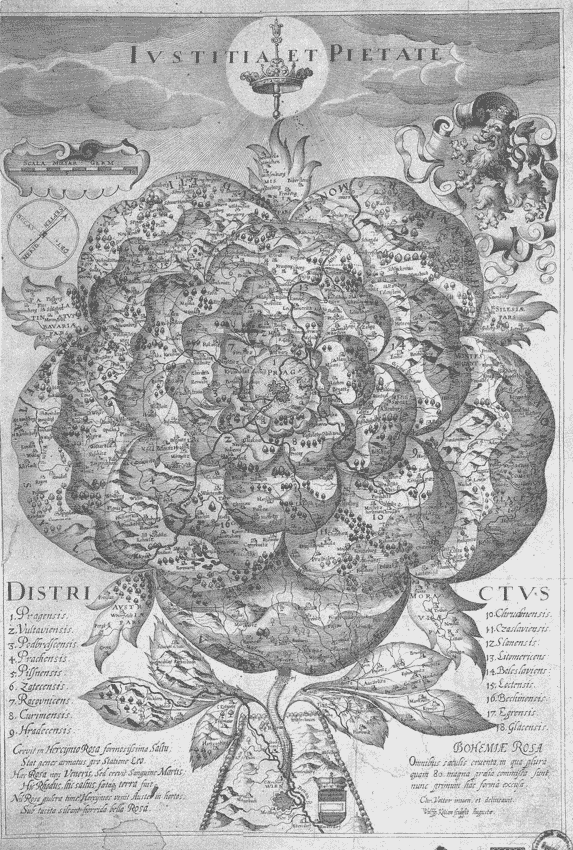
s e j n b o h e m i ae r o s a

The Bohemian Rose by Christoph Vetter, 1677
This beautiful map which
depicts Bohemia as a stylized
rose - Bohemiae Rosa - was
drawn by Christoph Vetter
for Bohuslav Balbin's work of
national history and
geography Epitome historica
Rerum Bohemicarum.
Wolfgang Kilian, an engraver
from Augsburg, made the
copper engraving from a copy of
Vetterês drawing in
1668. The top of the map bears
the motto of the Austrian
emperor, Leopold I, "Iustitia
et Pietate" (With Justice and
Piety). The 18 administrative
units of that period are listed
on the lower part of the
sheet. This included 14 regions,
Prague, and three territories
which had legal privileges
(i.e. Loket, Cheb and Hlad).
The translation of the latin
text is:"There grew a
graceful Rose in the Bohemian
woods, and an armoured
lion standing guard next to her.
That Rose had grown out of the
blood of Mars, not of
Venus. There was Rhodes as well
as the jump and the
country was created at once. Do
not fear, lovely Rose!
There comes the Austrian. May
the gun of frightful shots
cease under the stifled Rose!
The Rose of Bohemia,
bloody for all the centuries,
where more than 80 battles
were waged. She has been now
drawn in this form for the
first time."
EPITOME HISTORICA RERVM
BOHEMICARVM QVAM OB VENERATIONEM
CHRISTIANAE ANTIQVITATIS, ET
PRIMAE IN BOHEMIA COLLEGIALIS ECCLESIAE HONOREM,
BOLESLAVIENSEM HISTORIAM
PLACVIT APPELLARE. In ea, Pleraque in Historijs
nostris incerta, contraversa,
obsura; multa item ab alijs praeterita, summa fide, diligentia, claritate, &
brevitate QVINQVE LIBRIS
explicantur, & statuuntur; Adjecti sunt Libri duo (VI. & VII) de
Antiquissimo Boleslaviensis
Ecclesiae Collegio; deque Origine & Miraculis Magnae DEI Matris,
quae ibidem in Basilica sua
summa Populi veneratione colitur. AUTHORE BOHUSLAO BALBINO
e SOCIETATE JESU, CUM GRATIA &
PRIVILEGIO SAC: CAES: MAIESTATIS. PRAGAE,
Typis Universitatis
CAROLO-FERDINANDEAE, in Collegio Societatis JESU, ad Sanctum
Clementem, per Joannem Nicolaum
Hampel Factorem. Anno M.DC.LXXVII.